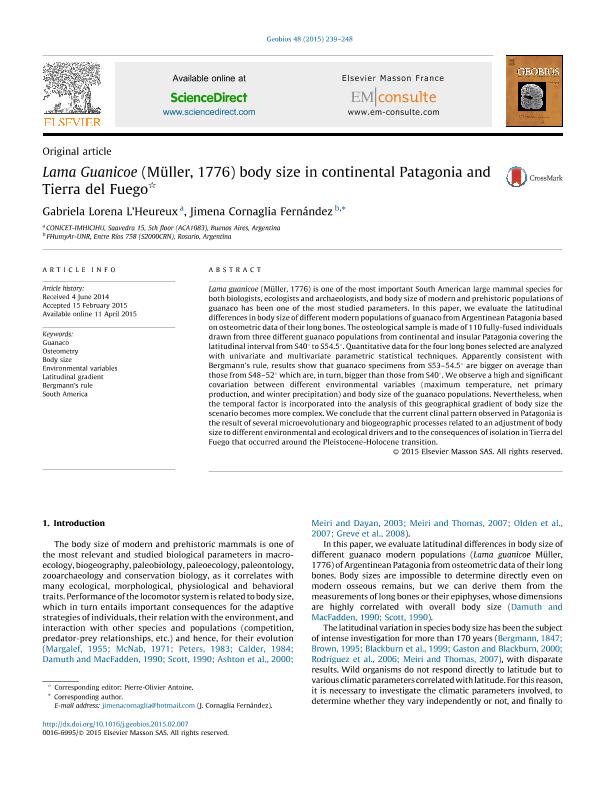Mostrar el registro sencillo del ítem
dc.contributor.author
L'heureux, Gabriela Lorena

dc.contributor.author
Cornaglia Fernández, Jimena

dc.date.available
2016-04-21T14:47:32Z
dc.date.issued
2015-04-11
dc.identifier.citation
L'heureux, Gabriela Lorena; Cornaglia Fernández, Jimena; Lama Guanicoe (Muller, 1776) body size in continental Patagonia and Tierra del Fuego; Elsevier Masson; Geobios; 48; 3; 11-4-2015; 239-248
dc.identifier.issn
0016-6995
dc.identifier.uri
http://hdl.handle.net/11336/5303
dc.description.abstract
Lama guanicoe (Muller, 1776) is one of the most important South American large mammal species for both biologists, ecologists and archaeologists, and body size of modern and prehistoric populations of guanaco has been one of the most studied parameters. In this paper, we evaluate the latitudinal differences in body size of different modern populations of guanaco from Argentinean Patagonia based on osteometric data of their long bones. The osteological sample is made of 110 fully-fused individuals drawn from three different guanaco populations from continental and insular Patagonia covering the latitudinal interval from S40° to S54.5°. Quantitative data for the four long bones selected are analyzed with univariate and multivariate parametric statistical techniques. Apparently consistent with Bergmann's rule, results show that guanaco specimens from S53-54.5° are bigger on average than those from S48-52° which are, in turn, bigger than those from S40°. We observe a high and significant covariation between different environmental variables (maximum temperature, net primary production, and winter precipitation) and body size of the guanaco populations. Nevertheless, when the temporal factor is incorporated into the analysis of this geographical gradient of body size the scenario becomes more complex. We conclude that the current clinal pattern observed in Patagonia is the result of several microevolutionary and biogeographic processes related to an adjustment of body size to different environmental and ecological drivers and to the consequences of isolation in Tierra del Fuego that occurred around the Pleistocene-Holocene transition.
dc.format
application/pdf
dc.language.iso
eng
dc.publisher
Elsevier Masson

dc.rights
info:eu-repo/semantics/openAccess
dc.rights.uri
https://creativecommons.org/licenses/by-nc-sa/2.5/ar/
dc.subject
Guanaco
dc.subject
Body Size
dc.subject
Environmental Variables
dc.subject
Bergman'S Rule
dc.subject.classification
Arqueología

dc.subject.classification
Historia y Arqueología

dc.subject.classification
HUMANIDADES

dc.title
Lama Guanicoe (Muller, 1776) body size in continental Patagonia and Tierra del Fuego
dc.type
info:eu-repo/semantics/article
dc.type
info:ar-repo/semantics/artículo
dc.type
info:eu-repo/semantics/publishedVersion
dc.date.updated
2016-05-06 15:52:43.262787-03
dc.journal.volume
48
dc.journal.number
3
dc.journal.pagination
239-248
dc.journal.pais
Francia

dc.journal.ciudad
Paris
dc.description.fil
Fil: L'heureux, Gabriela Lorena. Consejo Nacional de Investigaciones Científicas y Técnicas. Oficina de Coordinación Administrativa Saavedra 15. Instituto Multidisciplinario de Historia y Ciencias Humanas; Argentina
dc.description.fil
Fil: Cornaglia Fernández, Jimena. Universidad Nacional de Rosario. Facultad de Humanidades y Artes; Argentina
dc.journal.title
Geobios

dc.relation.alternativeid
info:eu-repo/semantics/altIdentifier/url/http://www.sciencedirect.com/science/article/pii/S0016699515000327
dc.relation.alternativeid
info:eu-repo/semantics/altIdentifier/doi/10.1016/j.geobios.2015.02.007
dc.relation.alternativeid
info:eu-repo/semantics/altIdentifier/doi/http://dx.doi.org/10.1016/j.geobios.2015.02.007
Archivos asociados
